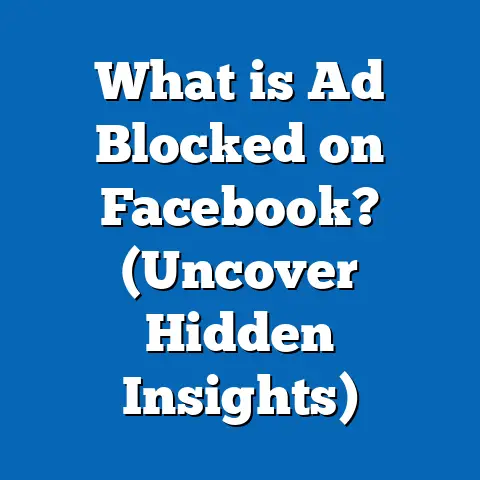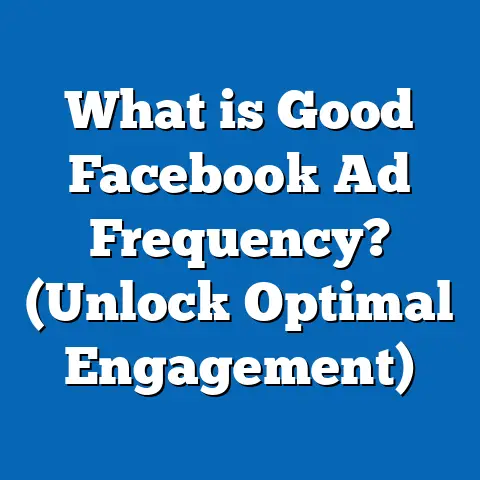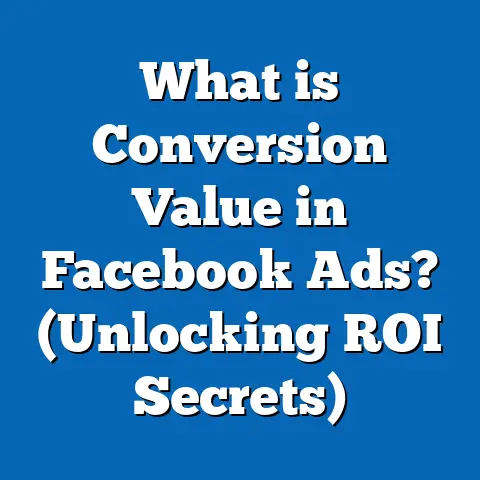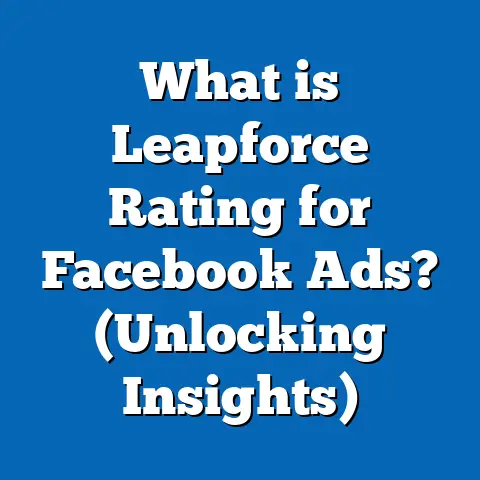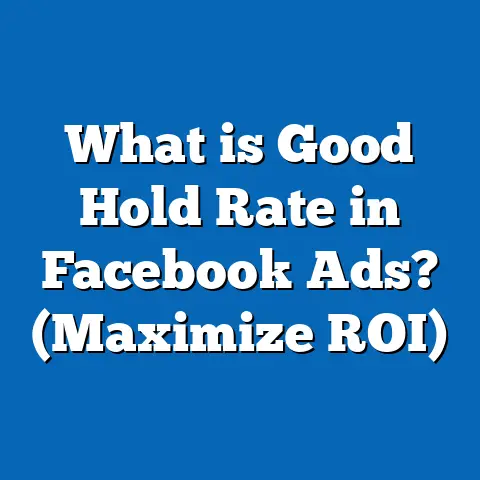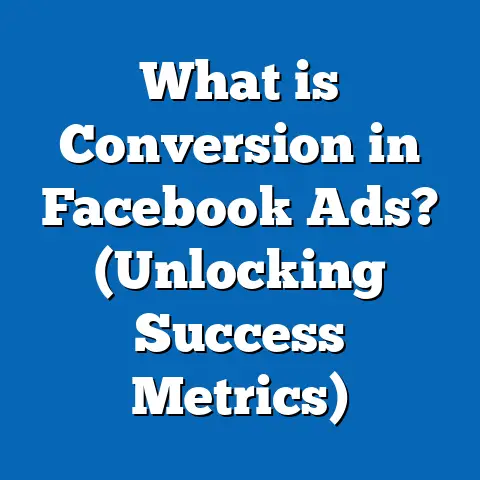What is Facebook Ads (Unlocking Targeted Marketing Success)
What is Facebook Ads (Unlocking Targeted Marketing Success)
Introduction: Challenging the Misconception of Facebook Ads as Just “Simple Boosting”
Many marketers and business owners mistakenly think Facebook Ads are simply about boosting posts or making basic ads to get quick likes or followers. This misunderstanding leads to missed opportunities and wasted budgets. Facebook Ads are actually one of the most sophisticated, data-driven advertising platforms available today.
With over 2.9 billion monthly active users worldwide on Facebook alone (Statista Q1 2024), the platform offers unmatched reach combined with advanced targeting capabilities. Through machine learning, granular audience segmentation, and real-time optimization, Facebook Ads allow businesses to target the right person with the right message at the right time—something far beyond simple boosting.
Table of Contents
- Understanding Facebook Ads: The Basics and Beyond
- How Facebook Ads Work: Step-by-Step Breakdown
- Deep Dive into Audience Targeting
- Ad Formats and Creative Best Practices
- Budgeting, Bidding Strategies & Optimization
- Measuring Success: Key Metrics and Analytics
- Case Studies: Real-World Examples of Facebook Ads Success
- Comparing Facebook Ads with Other Advertising Platforms
- Latest Trends and Future Outlook for Facebook Ads
- Practical Tips for Maximizing Your Campaigns
- Common Mistakes to Avoid in Facebook Advertising
- Conclusion: Actionable Next Steps for Marketers
Understanding Facebook Ads: The Basics and Beyond
What Exactly Are Facebook Ads?
Facebook Ads are paid advertisements created through Facebook’s Ads Manager that appear across Facebook’s family of apps: Facebook, Instagram, Messenger, and the Audience Network.
Unlike organic posts, these ads are targeted to specific users based on detailed data signals including demographics (age, gender), behaviors (shopping habits), interests (pages liked), location, and more.
Facebook Ads come in various formats such as single image ads, video ads, carousel ads (multiple images/videos in one ad), collection ads (mobile shopping experience), and lead generation ads.
Why Are Facebook Ads Important for Businesses?
- Massive Reach: With nearly 3 billion monthly active users on Facebook alone, there’s no other platform with similar scale.
- Precision Targeting: You can target users as narrowly as people who visited your website in the last 30 days or as broadly as all women aged 25–40 interested in fitness.
- Cost Efficiency: You control your budget with flexible options starting from just a few dollars a day.
- Measurable Results: Real-time reporting lets you see exactly what’s working and optimize continuously.
- Multi-Platform Impact: Ads can run seamlessly on Instagram, Messenger, and across millions of third-party apps/sites.
Data at a Glance: Why Advertisers Choose Facebook
- According to eMarketer 2024, over 88% of social media advertisers worldwide use Facebook Ads.
- Average Click-Through Rate (CTR) for Facebook Ads across industries is 0.89% (WordStream 2023).
- Businesses report an average Return on Ad Spend (ROAS) of 4.1x when using Facebook advertising effectively (Facebook Business Insights 2023).
How Facebook Ads Work: Step-by-Step Breakdown
Step 1: Setting Clear Campaign Objectives
Facebook offers multiple campaign objectives structured around different marketing goals:
| Objective | Description | Ideal For |
|---|---|---|
| Brand Awareness | Increase awareness of your brand | New product launches, awareness |
| Reach | Show ads to as many people as possible | Broad exposure |
| Traffic | Drive users to website or app | Website visits, blog traffic |
| Engagement | Increase post likes/comments/shares | Community building |
| App Installs | Encourage app downloads | Mobile apps |
| Video Views | Promote video content | Storytelling |
| Lead Generation | Collect leads directly in Facebook | Newsletter signups, inquiries |
| Conversions | Drive actions like sales or signups | E-commerce sales, registrations |
| Catalog Sales | Promote products from a catalog | E-commerce product sales |
| Store Traffic | Drive foot traffic to physical stores | Local businesses |
Selecting the right objective aligns ad delivery optimization with your business goals.
Step 2: Building Your Audience — The Heart of Targeting
Facebook’s targeting engine is its competitive advantage. Strategies include:
Core Audiences
Target based on:
- Location (Country, city, radius)
- Demographics (Age, gender, education)
- Interests (Pages liked, hobbies)
- Behaviors (Online purchases, travel habits)
- Connections (People connected to your Page or event)
Custom Audiences
Upload your own customer data such as:
- Email lists
- Phone numbers
- Website visitors (using Facebook Pixel)
- App users
This allows retargeting warm leads or loyal customers.
Lookalike Audiences
Facebook finds new people resembling your best customers by analyzing shared traits.
Insight: Lookalike Audiences can increase conversion rates by up to 30% compared to standard interest targeting (Facebook Business Case Studies 2023).
Step 3: Choosing Ad Placements
You can choose:
- Automatic placements: Let Facebook optimize where ads show.
- Manual placements: Pick specific platforms like Instagram Stories or Audience Network.
Each placement has different costs and engagement levels.
Step 4: Setting Budget and Bidding Strategies
Budgets can be:
- Daily Budget: Amount spent each day.
- Lifetime Budget: Total spend over campaign duration.
Bidding options include:
- Lowest Cost: Facebook bids to get most results at lowest cost.
- Cost Cap: Control max cost per action.
- Bid Cap: Set maximum bid amount.
- Target Cost: Maintain consistent cost per result.
Choosing the right bid strategy depends on competition and campaign goals.
Step 5: Creating Your Ads — Formats & Best Practices
Facebook offers a variety of ad formats:
| Format | Description | Best Use Case |
|---|---|---|
| Image Ads | Single image with text and CTA | Simple product/service promotion |
| Video Ads | Short videos telling a story | Brand storytelling & engagement |
| Carousel Ads | Multiple images/videos in one ad | Showcasing multiple products |
| Slideshow Ads | Lightweight video-like ads made from images | Low bandwidth user targeting |
| Collection Ads | Instant shopping experience on mobile | E-commerce product discovery |
| Lead Ads | Forms integrated within Facebook for lead capture | Collect contacts quickly |
Deep Dive into Audience Targeting
Why Audience Targeting Is Critical
A study by HubSpot in 2023 found that personalized ad targeting leads to a 50% increase in conversion rates compared to generic ads. This highlights why knowing your audience inside out is vital.
How to Build Effective Core Audiences
Start broad and narrow down:
- Define your ideal customer demographics.
- Layer interests related to your product/service.
- Use behaviors like recent purchases or device usage.
- Exclude irrelevant groups to avoid wasted spend.
For example, a fitness brand might target:
- Women aged 25–40
- Interested in yoga and healthy eating
- Who recently purchased fitness gear online
Leveraging Custom Audiences for Retargeting
Custom Audiences allow you to reconnect with people who have interacted with your brand already.
Examples:
- Website Visitors: Retarget users who viewed a product but didn’t purchase.
- Video Viewers: Target people who watched at least 50% of your videos.
- Customer Lists: Upload emails for special offers or loyalty campaigns.
Retargeting typically yields higher conversion rates since audiences are already familiar with your brand.
Using Lookalike Audiences to Scale Growth
Lookalike Audiences enable you to find new potential customers similar to your best existing ones by matching patterns in demographics, interests, and behaviors.
How to create Lookalikes effectively:
- Use a high-quality source audience (minimum 1,000 people).
- Choose similarity level (1% is most similar; higher % increases size but lowers similarity).
- Combine Lookalikes with layered interests for precision.
Ad Formats and Creative Best Practices
Image Ads
Keep images simple and clear with minimal text—Facebook recommends keeping text under 20% of the image area for better delivery.
Video Ads
Videos under 15 seconds typically perform best. Start with engaging visuals within first 3 seconds.
Use subtitles because many users watch videos without sound.
Carousel Ads
Use carousel ads to showcase multiple products or features in one ad unit. Each card can have its own link.
Collection Ads
Great for e-commerce brands; allow users to browse products directly within the ad before clicking through.
Lead Generation Ads
Optimize forms for mobile friendliness and minimize required fields to increase completion rates.
Budgeting, Bidding Strategies & Optimization
How Much Should You Spend on Facebook Ads?
Budgets vary widely based on goals and industry:
- Small businesses often start with $5–$20/day.
- Mid-sized companies might spend $1,000–$5,000/month.
- Large enterprises can allocate $50,000+ monthly budgets.
Set realistic expectations based on your sales funnel conversion rates and customer lifetime value (CLV).
Choosing Bidding Strategies That Work
| Strategy | When to Use |
|---|---|
| Lowest Cost | Beginners or when budget is limited |
| Cost Cap | Maintain consistent CPA |
| Bid Cap | Control max bid in competitive niches |
| Target Cost | Stable cost per conversion |
Test different strategies early on to identify what works best.
Campaign Budget Optimization (CBO)
CBO automatically distributes budget across ad sets based on performance. It is recommended for campaigns with multiple ad sets targeting different audiences or creatives.
Measuring Success: Key Metrics and Analytics
Metrics Every Marketer Must Track
| Metric | What It Shows | Why It Matters |
|---|---|---|
| Impressions | Number of times ads were shown | Indicates reach potential |
| Reach | Unique people who saw your ad | Shows audience size |
| Click-Through Rate (CTR) | % who clicked ad after seeing it | Measures engagement effectiveness |
| Conversion Rate | % completing desired action | Measures campaign effectiveness |
| Cost Per Click (CPC) | Average cost per link click | Helps manage budget efficiency |
| Cost Per Acquisition (CPA) | Cost per conversion | Key profitability metric |
| Return On Ad Spend (ROAS) | Revenue generated per dollar spent | Ultimate ROI measurement |
Using Facebook Analytics Tools Effectively
Facebook’s Ads Manager provides detailed breakdowns including:
- Demographic reports
- Device type performance
- Placement reports
- Time-of-day analysis
Use these insights to adjust targeting, creative assets, and bids for continuous improvement.
Case Studies: Real-World Examples of Facebook Ads Success
Case Study 1: E-commerce Apparel Brand — Scaling Revenue by 250%
Background: A mid-sized online apparel retailer wanted to increase revenue from their top-selling products using Facebook Ads.
Strategy:
- Created Lookalike Audiences based on top 10% customers by purchase value.
- Used dynamic creative testing with carousel ads showcasing bestsellers.
- Optimized for conversions with Campaign Budget Optimization enabled.
Results:
- Sales increased by 250% over three months.
- Cost per acquisition decreased by 35%.
- ROAS reached 5.2x.
Case Study 2: Local Cleaning Service — Reducing Lead Costs by Half
Background: Local cleaning company aimed to generate more leads without increasing ad spend.
Strategy:
- Focused on Lead Generation objective using lead forms optimized for mobile users.
- Targeted homeowners within a 20-mile radius using Core Audiences.
- Retargeted website visitors who browsed pricing pages but didn’t book service.
Results:
- Lead volume increased by 40%.
- Cost per lead dropped by 50%.
- Bookings increased by 60% year-over-year.
Comparing Facebook Ads with Other Advertising Platforms
Google Ads vs Facebook Ads
| Aspect | Google Ads | Facebook Ads |
|---|---|---|
| User Intent | High intent; users searching actively | Lower intent; discovery-based |
| Targeting Options | Keywords & intent-based | Demographics & behavior-based |
| Cost | Typically higher CPC | Generally lower CPC |
| Best For | Direct response & immediate conversion | Brand awareness & audience building |
Instagram Ads vs Facebook Ads
Instagram is owned by Meta and uses the same ad system but targets a younger demographic with more visual content focus.
LinkedIn Ads vs Facebook Ads
LinkedIn excels in B2B targeting but usually costs more per click due to professional audience niche focus.
TikTok Ads vs Facebook Ads
TikTok offers viral potential with younger demographics but has less mature advertising tools compared to Facebook’s extensive features.
Latest Trends and Future Outlook for Facebook Ads
Privacy Changes Impacting Targeting
Apple’s iOS updates and GDPR have limited tracking capabilities, pushing advertisers toward aggregated event measurement models and first-party data reliance.
Video & Reels Dominance
Short-form videos like Reels now drive higher engagement rates than static posts or longer videos.
AI-Powered Creative Tools
Facebook increasingly integrates AI tools that help automate creative testing and ad copywriting.
Augmented Reality (AR) Experiences
AR ads let users try products virtually before buying—a growing trend especially in fashion and cosmetics sectors.
E-Commerce Integration Growth
Facebook Shops paired with dynamic ads make online shopping seamless within social apps.
Practical Tips for Maximizing Your Campaigns
- Define Clear Goals — Know what success looks like before launching.
- Use High-quality Visuals — Invest in professional images/videos.
- Leverage Retargeting — Recapture warm audiences frequently.
- Test Creatives Regularly — Rotate ads every 7–14 days.
- Utilize Custom & Lookalike Audiences — Expand reach smartly.
- Optimize Budgets with CBO — Let Facebook find best-performing ad sets.
- Track Metrics Closely — Adjust based on real-time results.
- Avoid Overlapping Audiences — Prevent internal competition between ads.
- Stay Updated on Platform Changes — Adapt quickly as features evolve.
- Consider Professional Help — For complex campaigns, consult certified experts.
Common Mistakes to Avoid in Facebook Advertising
- Targeting too broadly without refining audiences.
- Ignoring mobile optimization of creatives.
- Using excessive text in images leading to poor delivery.
- Not setting up proper tracking (Facebook Pixel).
- Running static creatives too long causing ad fatigue.
- Over-relying on automatic settings without manual tweaks.
- Ignoring negative feedback or comments on ads.
- Failing to test different bidding strategies.
Conclusion: Actionable Next Steps for Marketers
Facebook Ads offer unmatched potential when used strategically. To unlock this power:
- Start by defining crystal-clear campaign objectives linked directly to business goals.
- Build detailed audiences using Core, Custom, and Lookalike segments.
- Choose ad formats aligned with your message and test multiple creatives continuously.
- Budget smartly using flexible bidding strategies and Campaign Budget Optimization.
- Monitor key metrics daily and optimize campaigns based on data insights.
- Stay current with platform updates and emerging trends like video dominance and privacy shifts.
- Learn from real-world case studies and adapt proven tactics to your business context.
By following these steps systematically, marketers can transform basic boosting misconceptions into targeted marketing success that drives measurable results at scale.
If you want further assistance such as templates for campaign setup or deep technical guides on pixel installation or API integrations, I’m ready to help!

